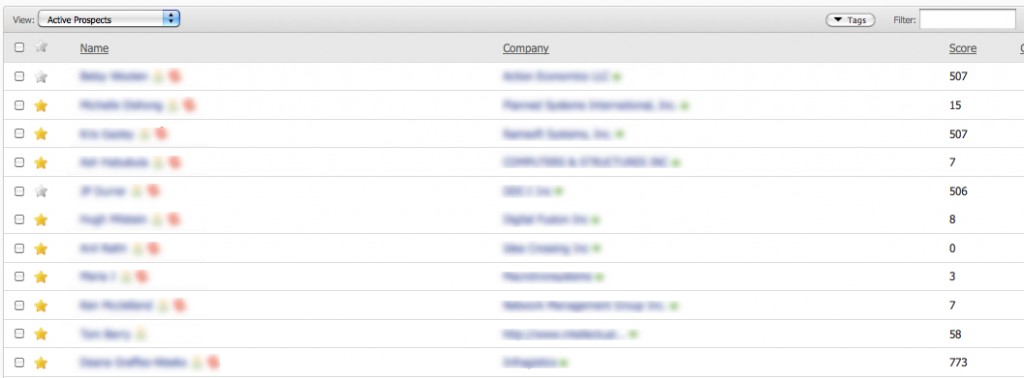by gabriel_sales | Oct 30, 2012
 One question we keep hearing around the B2B sales world is, “Does blogging work for B to B?”. This is because recently, many B2B companies have started catching on to the trend of blogging. Forrester reported that in 2010, 49 percent of B2B companies kept a corporate blog and in 2011, 114 Fortune 500 companies were regularly updating their blogs. So, why are corporations taking part in this social media trend? Because it works!
One question we keep hearing around the B2B sales world is, “Does blogging work for B to B?”. This is because recently, many B2B companies have started catching on to the trend of blogging. Forrester reported that in 2010, 49 percent of B2B companies kept a corporate blog and in 2011, 114 Fortune 500 companies were regularly updating their blogs. So, why are corporations taking part in this social media trend? Because it works!
Here are 12 reasons blogging works in B2B sales:
- Blogging Makes You Human. B2B customers like to interact on a personal level and blogging helps you seem more personable. Blogs can be less formal than e-newsletters or white papers and therefore give you the opportunity to express your humanness and unique personality. By putting out a public and personal face to your customers, you can interact with them on an individual level, motivating more people to purchase your product or service.
- Blogging Gets People to Your Website. In your blog, you should have links that go back to your main website. These links are one of the most effective ways you can drive traffic to your website.
- Blogging Generates Leads. HubSpot recently found that 57 percent of organizations with blogs report having gained new customers through their blogging efforts. Blogging is arguably more effective at generating leads than either Facebook or Twitter.
- Blogging Keeps Your Website Fresh and Relevant. The basic information on your website is likely pretty static. Mission statements and contact information do not change often. However, with a blog, you can give your potential customers a reason to come back repeatedly by mirroring all of your blogs on your website. If a potential leads find something new and fresh every time they visit your site, they are likely to think you are informed and up-to-date on market trends.
- Blogging Improves Search Engine Optimization. Blogs are great for SEO because, unlike your website, each individual blog you write can end up as a separate search result. Having multiple blogs with similar keywords increases the likelihood that you will show up multiple times on a search results page.
- Blogging Synergizes Social Media Efforts. Blogs should have links to your social media sites and vice versa. A recent study found that companies with blogs have two times as many followers on Twitter than companies without blogs. This shows that blogs are an effective means of driving people to your various social media sites.
- Blogging Improves Branding. With a blog, you are able to control the information that goes out to the public. Therefore, you can use a blog to exercise control over your brand image in a way that is impossible on other social media sites.
- Blogging Shows You Are an Expert. Informative or educational blogs can be used to position yourself as an industry expert. If you can demonstrate expertise to your readers, your product or service starts to look much more appealing.
- Blogging Captured Media Interest. If you are successful in positioning yourself as an expert and have something timely or interesting to say, your blog can become news. The media is always looking for the newest, greatest ideas and media coverage of blogs is a great way to expand brand awareness.
- Blogging Provides Feedback and Builds Community. Blogging creates a two-way communication model through the opportunity to leave comments. It is therefore an excellent tool for gaining understanding of your target audience. Comments let you have instant feedback on the blogs you write, allowing you to make constant adjustments to your message based on your readers’ reaction. These comments can then turn into lively conversations, which also can help you build a network of relationships with potential customers and other industry leaders.
- Blogging Distributes News & Information. This is one of the main ways a corporate blog is used. Blogging lets you share news about changes in corporate policy, a new location opening, or information about future seminars or trade shows. Pretty much anything you want your customers to know can go in a blog.
- Blogging Promotes Your Products/Services. You can also use blogging in a purely promotional manner. Similar to writing a press release, you can translate ad copy into a news style article and promote new products, services, promotions and more all through your corporate blog.
If you still need convincing that blogging works for B2B sales or would like to discuss a strategy for creating a corporate blog of your own, please feel free to request a review.
by gabriel_sales | Oct 25, 2012
 Audience segmentation, also called market segmentation, is an important aspect of creating an effective sales or marketing strategy. Most basically, it is about finding better customers. In past decades, marketing has generally been directed at mass audiences, sending the same message to all potential customers. Audience segmentation works to divide your target audience into groups that have similar interests or buying behavior.
Audience segmentation, also called market segmentation, is an important aspect of creating an effective sales or marketing strategy. Most basically, it is about finding better customers. In past decades, marketing has generally been directed at mass audiences, sending the same message to all potential customers. Audience segmentation works to divide your target audience into groups that have similar interests or buying behavior.
By dividing your audience into segments and crafting marketing messages targeted to each segment, you are able to reach each customer with marketing that is relevant to him or her. If your potential customer feels that your message is not relevant to them, you will most likely be ignored.
Segmentation also helps you build a better relationship with your potential customers because people are more likely to respond positively to messages they feel are directed to them personally. The more targeted your message, the more likely it becomes that your customer will engage with you.
With time, segmenting can also help you uncover potential market opportunities you might have otherwise missed, allowing you to create products and services better tailored around the specific needs and interests of your various customer segments.
What this means is that in today’s world, sending out a generic or mass message is no longer worth your time and could even end up costing you business. When you send out a mass-message that a customer has zero interest in, not only will you be ignored, but your customer may also see you as incompetent or uncaring.
What you want to do instead is give your customers information that is directly relevant to their personal needs and known buying behavior. If you do this correctly, audience segmentation can yield a substantial increase in response and engagement and, consequently, rates of conversion.
The most crucial aspect of implementing b2b marketing audience segmentation effectively is coming to understand what types of information each segment likes to consume and how each segment likes to consume it. With this information, you can create and target messages using the forms of media most in line with a segment’s purchasing behavior. For instance, if you know that a particular segment likes their content via videos, you’ll want to provide them links to your YouTube channel. Similarly, if you know an audience segment prefers to read text, you send them text in the form of emails, blogs or white papers.
The overall goal of audience or market segmentation is to avoid sending irrelevant messages to unreceptive customers. By understanding that different people (and different businesses) have different needs and media-consumption preferences, you can set up a marketing strategy that operates more efficiently and much more effectively.
by gabriel_sales | Oct 23, 2012
 In our last post, we discussed audience segmentation and why it is important for B2B marketing. To summarize, audience segmentation involves dividing your customers into groups based on their specific needs and purchasing behavior so that you can craft marketing messages to match each targeted group.
In our last post, we discussed audience segmentation and why it is important for B2B marketing. To summarize, audience segmentation involves dividing your customers into groups based on their specific needs and purchasing behavior so that you can craft marketing messages to match each targeted group.
When executed successfully, here are the 5 benefits of audience segmentation:
- Less Negative Feedback. When you stop sending messages to people who do not want them, you are much less likely to annoy people to the point of complaint.
- Increased Rates of Response. People are much more willing to respond to something if it is relevant to their interests.
- Decreased Marketing Expenditures. When you know who your target audience is, you do not waste time and money marketing to those outside the group.
- Decreased Long-term Costs. Audience segmentation also saves money by decreasing the amount of time spent following up on less qualified leads.
- Higher Rates of Conversion. By providing your customers with relevant purchasing information, you are much more likely to close.
Overall, audience segmentation is a key aspect of a successful sales and marketing strategy. For more information on the benefits of audience segmentation, please feel free to request a review.
by gabriel_sales | Oct 18, 2012
Quite obviously, business today is increasingly being done over the internet. This means that to succeed as a business in today’s globally connected world, your marketing strategy must have a significant digital component.
The answer to the question, “What is digital marketing?” is not as complicated as one may think. Digital marketing is essentially the same as traditional marketing; the only difference is the platform from which you send your message. Instead of communicating only via print outlets, your message now needs to come from multiple sources such as websites, blogs, emails and social networks.
The great opportunity that comes from these new forms of media is that they allow for a variety of new and highly effective ways of finding customers. We can now relay our message directly through e-newsletters; or we can reach customers by inviting them to watch self-made videos and podcasts. We can also find potential customers by creating websites and blogs that are relevant to our service or product. Finally, creating well-crafted pages on social networks can also find you potential customers.
There are many ways you can implement marketing online, and you must consider each of them carefully if you hope to create an effective marketing strategy.
It is first important to understand what is different about each of these platforms and how to use each of them to your advantage. For example, it is a very different thing to start a Twitter account than it is to send an e-newsletter. Another aspect to consider is that the digital world creates a two-way communication model that operates in a way that traditional one-way media never could. Negotiating this two-way form of communication requires you have knowledge of the new platforms so you can best exploit them to your advantage.
Overall, we should not see what digital marketing is as a vast departure from traditional marketing. The overall intent is still the same: we want to present potential customers with information to make an informed purchase. So, the difference is not what we do, but how we do things. Each new form of media carries with it its own internal logic; once we understand that logic, we can incorporate these media into our overall marketing strategy.
by gabriel_sales | Oct 8, 2012
Three Best Practices for Better B2B Lead Scoring
The new rules of engagement require you to get smarter about how you work the phone to ensure that you maximize every dollar spent on phone work. One requirement for b2b lead generation is to align your inside sales team with your marketing team by intelligently leveraging a marketing automation platform like Pardot for better lead scoring. This blog is part 2 of a 2 part series. Part 1 addressed the basics of sales b2b lead scoring to improve the performance of your sales and marketing b2b lead generation investment. Part 2 now introduces a framework to make your content marketing easier with a couple simple tips and some tool suggestions.
What’s does a solid process look like?
A solid process requires the basics we discussed in Part 1 of this series and the ability to capture both inferred data and direct data.
As each lead takes any action, their score will change. Your sales reps need to leverage your CRM to capture the Direct Data when they engage the prospect. Your Marketing teams will also collect direct data with well-built forms for inbound leads. Marketing Automation Software and a smart Content Management System makes collecting inferred data easy because it will track what type of content your prospects are looking at when they are visiting your website and social media sites. What you end up with is a composite score. The higher the score, the more qualified the lead. Below is a picture pulled from our platform.

How do I Score My Content? – B2B Lead Scoring Best Practice #2
The key to making your marketing automation software more productive is to design content around specific buying stages.

From there B2B lead scoring is easy:
- Educational Content like basic blog posts would get a score of 1
- Richer Educational Content and Whitepapers would get a score of 5
- Road Maps, Media Kits and Sales Sheets, Comparisons would get a score of 25
- Rate Cards, About Us Pages, Case Studies, and Technical Sheets would get a score of 100 and you would immediately flag these for sales to jump on to determine next actions
What if I Don’t Have A Lot of Content? – B2B Lead Scoring Best Practice #3
You need to get smarter about making your content work harder with a smart content management system that’s easy for non-technical employees to use (like WordPress) and a custom install of Gabriel Sales Digital Sales Basecamp™ as a tool to both, isolate content and to create landing pages, with a click of a mouse. This system allows you to customize your content for specific verticals, repurpose you content for specific decision makers so they can self-educate and, simultaneously, to isolate your content around specific buying stages.
The second step is to use a smart content management system like Gabriel Sales Digital Sales Basecamp and your Blog to organize your content so buyers can self- educate more easily and so you can offer your buyer different stage content on the same page.
Learn how to build a powerful B2B lead generation system, integrating sales and marketing, by viewing our resource page here.
 One question we keep hearing around the B2B sales world is, “Does blogging work for B to B?”. This is because recently, many B2B companies have started catching on to the trend of blogging. Forrester reported that in 2010, 49 percent of B2B companies kept a corporate blog and in 2011, 114 Fortune 500 companies were regularly updating their blogs. So, why are corporations taking part in this social media trend? Because it works!
One question we keep hearing around the B2B sales world is, “Does blogging work for B to B?”. This is because recently, many B2B companies have started catching on to the trend of blogging. Forrester reported that in 2010, 49 percent of B2B companies kept a corporate blog and in 2011, 114 Fortune 500 companies were regularly updating their blogs. So, why are corporations taking part in this social media trend? Because it works!
 Audience segmentation, also called market segmentation, is an important aspect of creating an effective sales or marketing strategy. Most basically, it is about finding better customers. In past decades, marketing has generally been directed at mass audiences, sending the same message to all potential customers. Audience segmentation works to divide your target audience into groups that have similar interests or buying behavior.
Audience segmentation, also called market segmentation, is an important aspect of creating an effective sales or marketing strategy. Most basically, it is about finding better customers. In past decades, marketing has generally been directed at mass audiences, sending the same message to all potential customers. Audience segmentation works to divide your target audience into groups that have similar interests or buying behavior.

